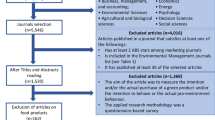Abstract
Transport problems typically involve at least two types of constraints, on income and on time. Therefore, the indirect utility function depends either on the income available after having subtracted the cost of the discrete alternative and on the free time left after having worked and travelled by each competing option. In the typical linear-in-the-attributes and in-the-parameters specification, that represents the first grade approximation of the indirect utility function, the effect of income and time constraints cancel out and only the cost and time of the alternatives matter in the comparison between them. From a microeconomic point of view this is equivalent to assume that income and time effects could be disregarded; which is not always the case. To account for these effects the utility function should include second order attributes; however, in non-linear utility functions it may not be easy to distinguish among several effects that could be relevant: direct preferences for good and leisure, and simple interactions between attributes other than income and time effects. This paper analyses these effects from a theoretical point of view focusing on the possible confounding problem in detecting income and time effects. We use a dataset collected for a modal choice context and containing both revealed and stated preference data, and estimate several NL models examining the effect of the different second-order terms on detecting income and time effects. We compared specifications including square cost and time attributes, interactions between time and cost, cost divided by the income available to be spent on free time, and time multiplied by free time. Our results confirm the strong effect of direct preferences for goods and leisure time on choice, and the potential confounding effect between quadratic attributes and other non-linear omitted terms. Finally, we also found that care should be taken in highlighting income and time effects using mixed data sources, since confounding effects can occur when non-linearities are accounted for in both data sets.
Similar content being viewed by others
References
Ben-Akiva ME, Morikawa T (1990) Estimation of travel demand models from multiple data sources. Proceedings 11th International Symposium on Transportation and Traffic Theory, Yokohama, Japan
Bradley MA, Daly AJ (1997) Estimation of logit choice models using mixed stated-preference and revealed-preference information. In: Stopher PR, Lee-Gosselin ME (eds), Understanding Travel Behaviour in an Era of Change. Pergamon, Oxford
Brownstone D (2001) Discrete choice modelling for transportation. In: Hensher DA (ed), Travel Behaviour Research: The Leading Edge. Pergamon, Amsterdam
Caussade S, de D Ortúzar J, Rizzi, LI Hensher DA (2005) Assessing the influence of design dimensions on stated choice experiment estimates. Transp Res 39B:621–640
Cherchi E, de D Ortúzar J (2002) Mixed RP/SP models incorporating interaction effects: modelling new suburban train services in Cagliari. Transportation 29:371–395
Cherchi E, Ortúzar J de D (2003a) Multimodal choice models with mixed RP/SP data: correlation, non-linearities and income effect. In: Selected Proceedings of the 9th World Conference on Transport Research, Pergamon, Amsterdam
Cherchi E, Ortúzar J de D (2003b) Alternative specific variables in non-linear utilities: influence of correlation, homoscedasticity and taste variations. 10th International Conference on Travel Behaviour Research (IATBR-2003), Lucerne, Switzerland
Cherchi E, Ortúzar J de D (2006) On fitting mode specific constants in the presence of new options in RP/SP models. Transp Res 40A:1–18
Cirillo C, Axhausen KW (2004) Evidence on the distribution of values of travel time savings from a six-week diary. Arbeitsbericht Verkehrs- und Raumplanung 212, IVT, ETH, Zurich
Daly AJ (1998) ALOGIT 3.8 User's Guide. Hague Consulting Group, The Hague
Gunn HF (1996) The 1985–1996 Dutch VOT Studies. In: Value of Time Seminar. PTRC, London
Gunn HF, Worsely T (1999) Implications of recent research into values-of-time for the classical transport model, forecast and appraisal. Proceedings 27th European Transport Conference, Cambridge, England
Jara-Díaz SR (1990) Valor subjetivo del tiempo y utilidad marginal del ingreso en modelos de partición modal. Apuntes de Ingeniería 39:41–49 (in Spanish)
Jara-Díaz SR (1998) A general micro-model of users' behaviour: the basic issues. In: Ortúzar J de D, Hensher DA, Jara-Díaz SR (eds), Travel behaviour research: updating the state of play, Elsevier Science, Oxford
Jara-Díaz SR, Farah M (1987) Transport demand and users' benefits with fixed income: the goods/leisure trade off revisited. Transp Res 21B:165–170
Jara-Díaz SR, Ortúzar J de D (1989) Introducing the expenditure rate in the estimation of mode choice models. Journal of Transport Economics and Policy 23:293–308
Jara-Díaz SR, Videla J (1989) Detection of income effect in mode choice: theory and application. Transp Res 23B:393–400
Leclerc F, Schmitt BH, Dubé L (1995) Waiting time and decision making: is time like money? J Consum Res 22:110–119
Louviere JJ, Hensher DA, Swait JD (2000) Stated choice methods: analysis and application. Cambridge University Press, Cambridge
Ortúzar, J de D (1994) Valor del Tiempo para Evaluación de Proyectos, Informe Ejecutivo para FONDECYT, Department of Transport Engineering, Pontificia Universidad Católica de Chile, Santiago (in Spanish)
Revelt D, Train KE (1998) Mixed logit with repeated choices: households' choice of appliance efficiency level. Rev Econ Stat 80:647–657
Sillano M, de D Ortúzar J (2005) Willingness-to-pay estimation with mixed logit models: some new evidence. Environ Plan 37A:525–550
Train KE, McFadden D (1978) The goods/leisure trade-off and disaggregate work trip mode choice models. Transp Res 12:349–353
Varian H (1978) Microeconomic analysis. Norton, New York
Wardman M (1996) Issues in model specification. In: Value of time seminar. PTRC, London
Author information
Authors and Affiliations
Corresponding author
Rights and permissions
About this article
Cite this article
Cherchi, E., de Dios Ortúzar, J. Income, Time Effects and Direct Preferences in a Multimodal Choice Context: Application of Mixed RP/SP Models with Non-Linear Utilities. Netw Spat Econ 6, 7–23 (2006). https://doi.org/10.1007/s11067-006-7682-7
Published:
Issue Date:
DOI: https://doi.org/10.1007/s11067-006-7682-7




